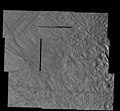Stampa:PIA01633 Tyre impact structure Europa.jpg

Daqs tad-dehra proviżorja: 666 × 599 pixels. Riżoluzzjonijiet oħra: 267 × 240 pixels | 533 × 480 pixels | 853 × 768 pixels | 1,138 × 1,024 pixels | 2,540 × 2,286 pixels
Fajl oriġinali (2,540 × 2,286 pixel, dimensjoni: 1.28 MB, tip ta' MIME: image/jpeg)
Kronoloġija tal-fajl
Agħfas fuq il-grupp data/ħin biex tara l-fajl biex tara kif jidher dak il-ħin.
| Data/Ħin | Minjatura | Qisien | Utent | Kumment | |
|---|---|---|---|---|---|
| kurrenti | 09:38, 22 Frar 2020 |  | 2,540 × 2,286 (1.28 MB) | User-duck | Cropped using CropTool with lossless mode. |
| 22:53, 13 Marzu 2010 |  | 2,686 × 2,494 (1.28 MB) | WolfmanSF | {{Information |Description={{en|1=This mosaic shows the Tyre multi-ring structure which is thought to have been formed by a large impact onto Jupiter's moon Europa. The effective crater (large bull's-eye feature) is about 40 kilometers (25 miles) across w |
Użu tal-fajl
Il-Paġna segwenti twassal għal din l-istampa:
L-użu globali tal-fajl
Il-wikis segwenti jużaw dan il-fajl:
- Użu fuq af.wikipedia.org
- Użu fuq de.wikipedia.org
- Użu fuq en.wikipedia.org
- Użu fuq fr.wikipedia.org
- Użu fuq ko.wikipedia.org
- Użu fuq nn.wikipedia.org
- Użu fuq no.wikipedia.org
- Użu fuq ro.wikipedia.org
- Użu fuq ru.wikipedia.org


